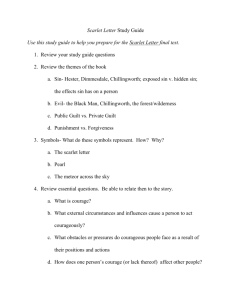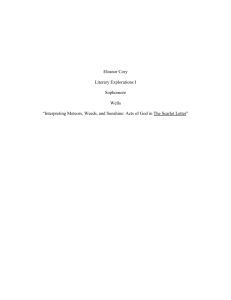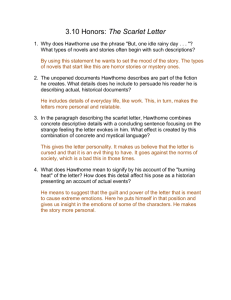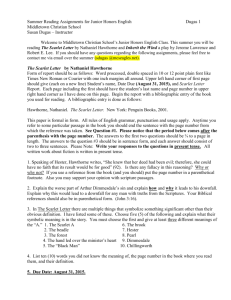Does true repentance eventually absolve one's guilt
advertisement
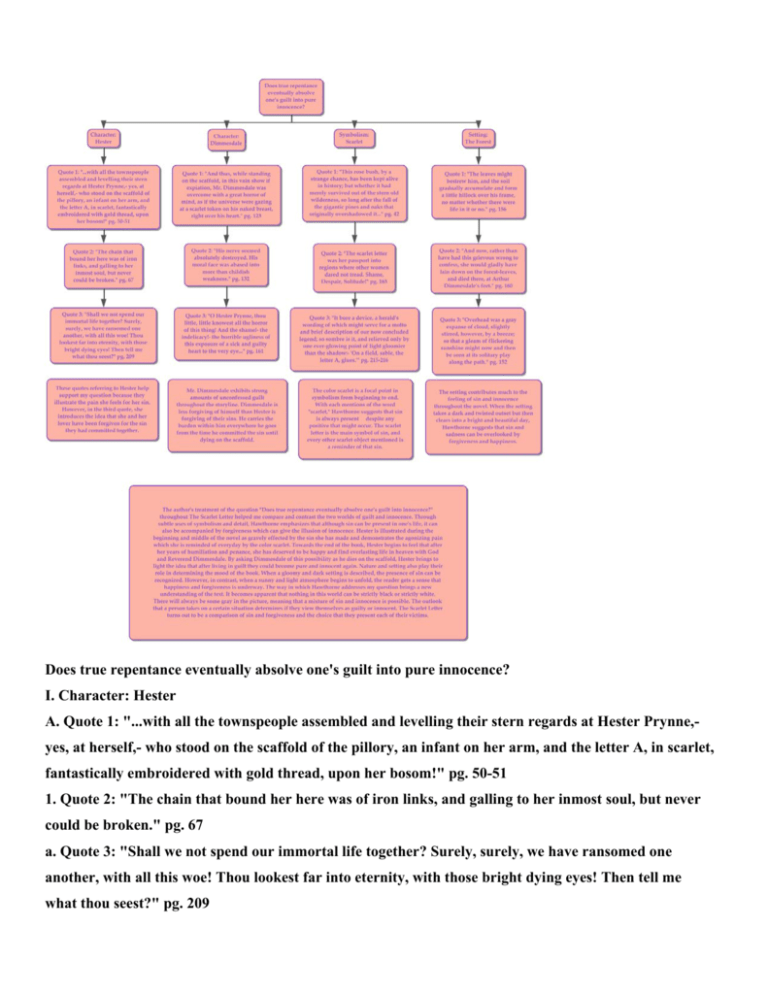
Does true repentance eventually absolve one's guilt into pure innocence? I. Character: Hester A. Quote 1: "...with all the townspeople assembled and levelling their stern regards at Hester Prynne,yes, at herself,- who stood on the scaffold of the pillory, an infant on her arm, and the letter A, in scarlet, fantastically embroidered with gold thread, upon her bosom!" pg. 50-51 1. Quote 2: "The chain that bound her here was of iron links, and galling to her inmost soul, but never could be broken." pg. 67 a. Quote 3: "Shall we not spend our immortal life together? Surely, surely, we have ransomed one another, with all this woe! Thou lookest far into eternity, with those bright dying eyes! Then tell me what thou seest?" pg. 209 II. Character: Dimmesdale A. Quote 1: "And thus, while standing on the scaffold, in this vain show if expiation, Mr. Dimmesdale was overcome with a great horror of mind, as if the universe were gazing at a scarlet token on his naked breast, right over his heart." pg. 123 1. Quote 2: "His nerve seemed absolutely destroyed. His moral face was abased into more than childish weakness." pg. 132 a. Quote 3: "O Hester Prynne, thou little, little knowest all the horror of this thing! And the shame!- the indelicacy!- the horrible ugliness of this exposure of a sick and guilty heart to the very eye..." pg. 161 III. Symbolism: Scarlet A. Quote 1: "This rose bush, by a strange chance, has been kept alive in history; but whether it had merely survived out of the stern old wilderness, so long after the fall of the gigantic pines and oaks that originally overshadowed it..." pg. 42 1. Quote 2: "The scarlet letter was her passport into regions where other women dared not tread. Shame, Despair, Solitude!" pg. 165 a. Quote 3: "It bore a device, a herald's wording of which might serve for a motto and brief description of our now concluded legend; so sombre is it, and relieved only by one ever-glowing point of light gloomier than the shadow:- 'On a field, sable, the letter A, glues.'" pg. 215-216 IV. Setting: The Forest A. Quote 1: "The leaves might bestrew him, and the soil gradually accumulate and form a little hillock over his frame, no matter whether there were life in it or no." pg. 156 1. Quote 2: "And now, rather than have had this grievous wrong to confess, she would gladly have lain down on the forest-leaves, and died there, at Arthur Dimmesdale's feet." pg. 160 a. Quote 3: "Overhead was a gray expanse of cloud, slightly stirred, however, by a breeze; so that a gleam of flickering sunshine might now and then be seen at its solitary play along the path." pg. 152 These quotes referring to Hester help support my question because they illustrate the pain she feels for her sin. However, in the third quote, she introduces the idea that she and her lover have been forgiven for the sin they had committed together. Mr. Dimmesdale exhibits strong amounts of unconfessed guilt throughout the storyline. Dimmesdale is less forgiving of himself than Hester is forgiving of their sins. He carries the burden within him everywhere he goes from the time he committed the sin until dying on the scaffold. The color scarlet is a focal point in symbolism from beginning to end. With each mentions of the word "scarlet," Hawthorne suggests that sin is always present despite any positive that might occur. The scarlet letter is the main symbol of sin, and every other scarlet object mentioned is a reminder of that sin. The setting contributes much to the feeling of sin and innocence throughout the novel. When the setting takes a dark and twisted outset but then clears into a bright and beautiful day, Hawthorne suggests that sin and sadness can be overlooked by forgiveness and happiness. The author's treatment of the question "Does true repentance eventually absolve one's guilt into innocence?" throughout The Scarlet Letter helped me compare and contrast the two worlds of guilt and innocence. Through subtle uses of symbolism and detail, Hawthorne emphasizes that although sin can be present in one's life, it can also be accompanied by forgiveness which can give the illusion of innocence. Hester is illustrated during the beginning and middle of the novel as gravely effected by the sin she has made and demonstrates the agonizing pain which she is reminded of everyday by the color scarlet. Towards the end of the book, Hester begins to feel that after her years of humiliation and penance, she has deserved to be happy and find everlasting life in heaven with God and Reverend Dimmesdale. By asking Dimmesdale of this possibility as he dies on the scaffold, Hester brings to light the idea that after living in guilt they could become pure and innocent again. Nature and setting also play their role in determining the mood of the book. When a gloomy and dark setting is described, the presence of sin can be recognized. However, in contrast, when a sunny and light atmosphere begins to unfold, the reader gets a sense that happiness and forgiveness is underway. The way in which Hawthorne addresses my question brings a new understanding of the text. It becomes apparent that nothing in this world can be strictly black or strictly white. There will always be some gray in the picture, meaning that a mixture of sin and innocence is possible. The outlook that a person takes on a certain situation determines if they view themselves as guilty or innocent. The Scarlet Letter turns out to be a comparison of sin and forgiveness and the choice that they present each of their victims.
